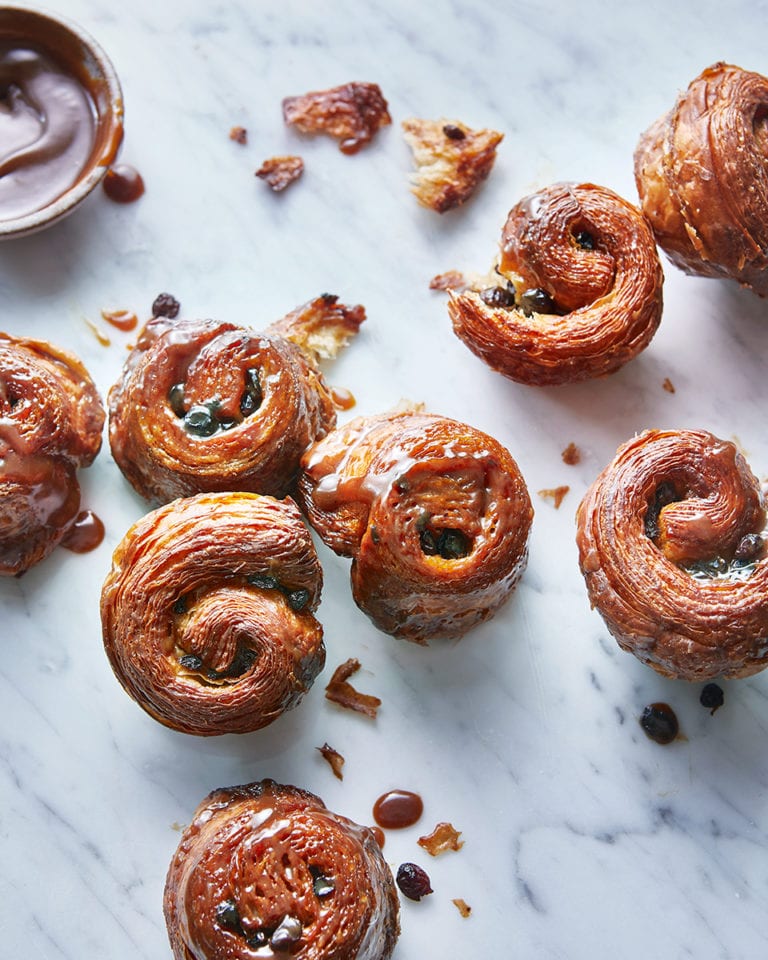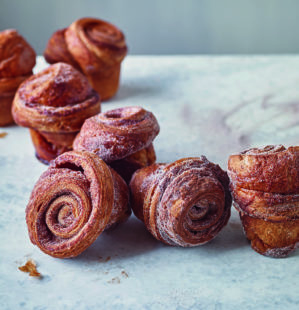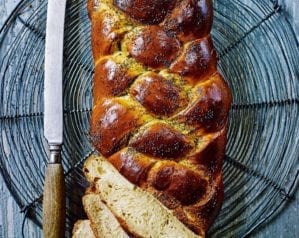
Flor’s lardy buns
- Published: 25 Mar 21
- Updated: 25 Mar 24
Fancy a challenge? These buns are proof that hard work will be rewarded! For the crispest, crunchiest and most satisfying breakfast bun, follow our step-by-step recipe for Flor bakery’s lardy buns. Make sure you factor in the resting and fermenting time.

In the heart of London’s Borough Market, Flor was set up by the team behind Lyle’s in Shoreditch and inspired by the Parisian buvettes that combine wine bar, bakery and restaurant in one.
These beautiful buns combine the rich flavours of a mace caramel and pork lard with the lightness of a croissant dough — and no ordinary croissant dough at that.
Scroll down to the “Tips” section for a helpful video.
-
Hands-on time 1 hour 30 min, plus at least 4 hours fermenting and 6-8 hours resting, chilling and proving.
Ingredients
For the croissant dough
- 225g poolish (see below)
- 190g cold water
- 110g cold milk
- 25g fresh yeast (from supermarket in-house bakeries)
- 40g unsalted soft butter, plus 500g unsalted butter for lamination
- 30g strong white flour, plus extra to dust
- 90g stoneground einkorn flour (see Know-how)
- 90g sifted wholewheat flour
- 100g demerara sugar
- 2 tsp salt
- 1 medium free-range egg, beaten with a pinch of salt, for glazing
- Oil for greasing
For the poolish
- 115g strong white flour
- 115g water (at room temperature)
- 2g fresh yeast or scant 1⁄4 tsp fast-action dried yeast
For the fruit filling
- 250g dried currants
- Pot of strong English breakfast tea
For the mace lard
-
- 100g lard
- 75g dark brown muscovado sugar
- 1 tsp ground mace (see Easy Swaps)
- 1⁄4 tsp salt
For the mace caramel
- 110g unsalted butter
- 215g dark brown muscovado sugar
- 175g double cream
- 1⁄4 tsp salt
- 1 tsp ground mace (see Easy Swaps)
You’ll also need
- Stand mixer with a dough hook
- Compostable baking paper
- 1-2 large muffin tins (about 200ml capacity holes), greased with veg oil
Method
Stage 1: Making the dough
-
- Start by preparing the poolish: stir the flour and water with the yeast in a medium bowl. Mix well, cover with a lid and set aside, at room temperature, to ferment for at least 4 hours. It should be bubbly and doubled in volume (see Make Ahead).
- To make the dough, mix 225g fermented poolish with the water, milk, fresh yeast and 40g soft butter in the bowl of a stand mixer fitted with a dough hook. Tip all the dry ingredients on top, then mix on a low speed until the dough starts to come together – about 2 minutes.
- Increase the speed to medium- high and work for at least 8-10 minutes until the dough starts to leave the sides of the bowl and looks smoother and elastic. Turn off the mixer and rest the dough for 3 minutes, then resume mixing on a medium speed for a further 3 minutes.
Recipe continues after advertisingAdvertisement - Tip out the dough onto a clean work surface and shape into a ball. Put the dough into a large oiled container with a tight-fitting lid and leave at room temperature for 1 hour, then chill for 2 hours or until at least doubled in size.
Stage 2: The lamination
-
- While the dough is chilling, prepare the 500g butter for lamination. Roll it between 2 sheets of compostable baking paper to a rectangle about 16cm x 20cm and 1cm thick. Chill for 1 hour, then remove 30 minutes prior to lamination (it needs to be malleable but not soft – ideally between 14°C and 18°C).
- Once the dough has had time to chill, roll it on a lightly floured work surface into a rectangle roughly 35cm x 20cm, with the longer side nearest you. Remove the butter from the baking paper and, with the short side nearest you, lay it across the centre of the dough to cover it, leaving 10cm dough on each side. Fold the sides of the dough over the butter so it’s now completely covered and the edges of the dough meet in the middle. Gently press down on the dough and pinch the edges to encase the butter, then roll the dough in the direction of the central seam. The aim is to lengthen the dough parcel (it will also get a little bit wider). Keep the pressure even so the butter rolls with the dough and doesn’t crack or ooze out at the seams. Stop rolling once the rectangle reaches roughly 45cm x 20cm – aim for as even a thickness as possible. Trim the short ends a little to neaten up the corners if needed.
- With the short end of the dough in front of you, fold the top third of the dough downwards and then fold over again (in half) to cover the bottom third, as if folding a letter. Return the dough to the container with the lid, then chill for 20-30 minutes, but no longer. If it gets too cold the butter may crack when rolled.
- Repeat the same rolling and folding process twice more, each time beginning with the spine of the ‘letter’ on the left, so the parcel is rotated 90 degrees each time you do a fold. Return the dough to the fridge for 20-30 minutes after each roll and fold.
- Once the third and final fold is complete, leave the dough to rest in the fridge for at least 1 hour (see Make Ahead). At this point there’s no danger of the butter cracking when you roll it because the layers are so thin.
Stage 3: The fillings
-
- While the dough rests, prepare the fillings. Put the dried currants in a heatproof bowl, pour over the hot tea to cover and leave for at least 30 minutes so the currants swell and soak up the liquid (see Make Ahead).
- For the mace lard, beat the lard with the sugar, mace and salt until smooth and well combined.
- To make the mace caramel, combine all the ingredients in a medium saucepan over a low heat. Cook, stirring occasionally to ensure the sugar doesn’t burn at the bottom, until melted. Increase the heat to medium-high and boil for 2-3 minutes (no stirring) until the caramel lightly coats the back of a wooden spoon. Remove from the heat and set aside (see Make Ahead).
Stage 4: The assembly & baking
-
- On a lightly floured surface, roll the chilled parcel of dough to about 16cm x 60cm x 8mm thick. Put the longest side of the dough sheet closest to you. Working quickly, spread the mace lard over the surface as evenly as possible. Drain the tea-soaked currants and sprinkle evenly over the dough. Starting at the edge closest to you, gently roll up the dough into a long thin sausage. Press down slightly once finished to help seal the edge (see Make Ahead). Using a sharp serrated knife, cut the sausage into cross-sections at 3-4cm intervals.
- Fill the prepared muffin tray holes with pieces of dough (cut-side-up). Press gently into the holes without disturbing the layers too much. Cover the tin with a clean, slightly damp tea towel or re-useable proving bag and leave the buns in a warm place for 2-2 1⁄2 hours or until almost doubled in size.
- Heat the oven to 200°C fan/ gas 7. Glaze the buns by brushing with a little beaten egg, then put the muffin tin on a large, lipped baking tray and bake for 20-25 minutes until the buns are a deep golden colour. Warm the caramel.
- As soon as the buns are out of the oven, carefully tip them out of the muffin tin onto a tray, then one-by-one dip them into the warm caramel to coat the bottoms (you’ll have caramel left over). Arrange the buns, caramel- coated side facing up, on the tray and cool a little before eating.
- Recipe from April 2021 Issue
Nutrition
- Calories
- 547kcals
- Fat
- 33.7g (19.8g saturated)
- Protein
- 5.7g
- Carbohydrates
- 54.1g (23.7g sugars)
- Fibre
- 2.5g
- Salt
- 0.7g
delicious. tips
If all the lamination sounds a little too much effort, you can make a Chelsea bun-style dough instead, then continue with Stages 3 and 4.
If you can’t get hold of mace, you can use ground nutmeg instead but it’s stronger so use a little less.
Watch the buns being made here:
The mace caramel and currants can be prepared 1-2 days in advance and stored in the fridge. The buns are best on the day they’re made but will keep for 2 days in an airtight container (refresh in a low oven for 5-10 minutes). The dough can also be frozen, either after lamination (Stage 2) or as an assembled log (before slicing). Defrost the buns in the fridge overnight before continuing the recipe. The buns may require an extra hour or so to prove after freezing. The poolish can be made up to 24 hours ahead. If you’re leaving it for more than 6 hours, mix as instructed, cover with cling film and chill until ready to use.
A poolish is a fermented dough used in many French-style bakery products to add flavour. Einkorn is a variety of wheat similar to spelt. It gives a nutty, toasty flavour and can be found at health food stores or online from Doves Farm. If you can’t find any, use sifted wholewheat spelt flour (widely available). Lamination is the repeated rolling and folding of dough to create many layers separated by butter. As it bakes, the butter releases steam and the layers puff apart – giving you the crisp, flaky pastry seen in a croissant.
Buy ingredients online
Rate & review
Rate
Reviews
Subscribe to our magazine
Food stories, skills and tested recipes, straight to your door... Enjoy 5 issues for just £5 with our special introductory offer.
Subscribe
Unleash your inner chef
Looking for inspiration? Receive the latest recipes with our newsletter






